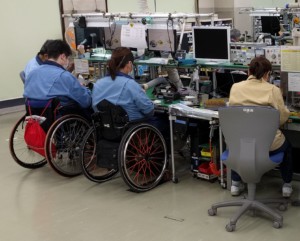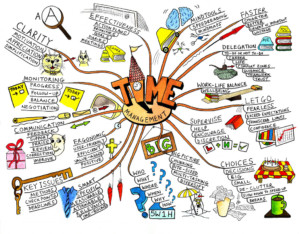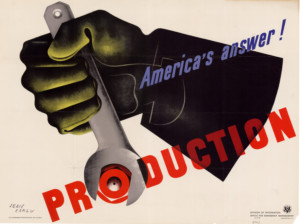 There is one word that currently takes the lean world by storm: kata, or more properly Toyota Kata, a method developed by Mike Rother. The idea behind it is not only a bunch of buzzwords (like all too often) but actually goes in the right direction. Overall, I like the concept, although the attention it gets sometimes feels overdone. Let me give you the gist of kata.
There is one word that currently takes the lean world by storm: kata, or more properly Toyota Kata, a method developed by Mike Rother. The idea behind it is not only a bunch of buzzwords (like all too often) but actually goes in the right direction. Overall, I like the concept, although the attention it gets sometimes feels overdone. Let me give you the gist of kata.
Management
All posts about management techniques, success stories, failures, etc.
Disabled Employees in Manufacturing – Omron Taiyo in Japan – Part 2
Disabled Employees in Manufacturing – Omron Taiyo in Japan – Part 1
 In every country, a part of the population has temporary or permanent disabilities that handicap their working ability. While in Japan, I was able to visit two factories of Omron Taiyo, in Kyoto and Beppu, where the majority of the employees have a disability. This was quite an enlightening experience for me, and I would like to share it with you. Due to the length of this post, I have split it into two parts.
In every country, a part of the population has temporary or permanent disabilities that handicap their working ability. While in Japan, I was able to visit two factories of Omron Taiyo, in Kyoto and Beppu, where the majority of the employees have a disability. This was quite an enlightening experience for me, and I would like to share it with you. Due to the length of this post, I have split it into two parts.
Creative Provocation, Reverse Brainstorming, and Analogy
 After showing you the details of a few basic creativity techniques, I now get to my most favorite one: creative provocation! It is a bit more advanced, but I had huge successes with this one. It is part of a group of techniques that alter the initial question to foster more creativity. I will also show you reverse brainstorming.
After showing you the details of a few basic creativity techniques, I now get to my most favorite one: creative provocation! It is a bit more advanced, but I had huge successes with this one. It is part of a group of techniques that alter the initial question to foster more creativity. I will also show you reverse brainstorming.
Fishbone Diagrams and Mind Maps
 A lot of lean problem solving requires creativity. There are many creativity techniques available to help generate ideas for problem solving. In my last post I presented brainstorming, which is a freewheeling creativity technique. In this post I will show you some creativity techniques that have a more structured approach. These include mind maps and fishbone diagrams. Both can be used in groups, but they are also helpful if you need to tackle problems on your own.
A lot of lean problem solving requires creativity. There are many creativity techniques available to help generate ideas for problem solving. In my last post I presented brainstorming, which is a freewheeling creativity technique. In this post I will show you some creativity techniques that have a more structured approach. These include mind maps and fishbone diagrams. Both can be used in groups, but they are also helpful if you need to tackle problems on your own.
How to Do Brainstorming
 A lot of lean is about problem solving, and most of these problems are complex and difficult. Otherwise, someone would have solved them already. Hence, I would like to introduce you to different creativity techniques for problem solving. Most of them can be used in groups to access the collective wisdom and creativity. Most of them are also suitable to develop a number of alternative solutions, of which you can pick the best ones (see my previous post on Japanese Multidimensional Problem Solving). Many of them can be combined in sequence. Let me start with the most common one, brainstorming:
A lot of lean is about problem solving, and most of these problems are complex and difficult. Otherwise, someone would have solved them already. Hence, I would like to introduce you to different creativity techniques for problem solving. Most of them can be used in groups to access the collective wisdom and creativity. Most of them are also suitable to develop a number of alternative solutions, of which you can pick the best ones (see my previous post on Japanese Multidimensional Problem Solving). Many of them can be combined in sequence. Let me start with the most common one, brainstorming:
Leading with Confidence
More on TWI Programs
 The TWI Program during World War II was very successful. Besides the Job Instructions, Job Methods, and Job Relations, a few other modules were developed, some of them internally. After the war, different institutions took over what the US government abandoned in December 1945. These follow-up institutions were the TWI Foundation and the TWI Inc. in the US; but it was also continued by the British TWI Service and the New Zealand TWI Service, and it was especially successful in Japan. Altogether, TWI was used in around seventy countries in 1960, although with quite different intensity and much less than when the US government used it through the war. This is the last in a series of five posts on TWI.
The TWI Program during World War II was very successful. Besides the Job Instructions, Job Methods, and Job Relations, a few other modules were developed, some of them internally. After the war, different institutions took over what the US government abandoned in December 1945. These follow-up institutions were the TWI Foundation and the TWI Inc. in the US; but it was also continued by the British TWI Service and the New Zealand TWI Service, and it was especially successful in Japan. Altogether, TWI was used in around seventy countries in 1960, although with quite different intensity and much less than when the US government used it through the war. This is the last in a series of five posts on TWI.


